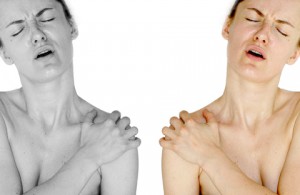What is fibromyalgia
Fibromyalgia is a diagnostic term for a chronic widespread centralised pain syndrome with attendant features. There is no diagnostic laboratory test or imaging. It is characterised by chronic widespread pain for which no physical explanation can be given. There are accompanying symptoms, which may or may not be present in an individual and will usually vary over time.

The diagnosis of fibromyalgia relies on the recognition of symptom complexes. In 1990 the first diagnostic criteria were developed. These relied on “tender point” identification. The American College of Rheumatology (ACR) adopted tender point identification as its diagnostic criterion and a diagnosis of fibromyalgia was made with a positive tender point examination in at least 11/18 of predefined areas of the body.
The reported prevalence of fibromyalgia varies between 2-5% of the general population, second only to osteoarthritis in chronic “rheumatic” diseases. It can develop at any age.
In 2010 the ACR refined its criteria to include the other symptoms associated with fibromyalgia. Using the 2010 criteria the female:male ratio of people with fibromyalgia is approximately 2:1. This ratio is in keeping with the female preponderance in other chronic pain syndromes and the prevalence of fibromyalgia is similar across ethnic groups and in different countries of the world.
A biological basis of fibromyalgia has been demonstrated using neuroimaging of the brain. People with fibromyalgia experience pain where others would perceive touch or pressure. Even tight clothing can stimulate pain in some sufferers. The imaging studies showed activity in pain processing areas, in those with fibromyalgia, in response to both pressure and temperature changes.
The Symptom Complex
Pain (required symptom for the diagnosis)
People with fibromyalgia usually have pain as the central symptom. The onset of the pain is usually insidious and may initially be localised. The pain may have a “neuropathic” quality with stinging, burning or tingling types of pain being reported. Physical examination for a cause of the pain may only reveal localised tenderness. The pain may start with an intermittent pattern but usually becomes more constant and widespread with time.
The severity of the pain (and other symptoms) varies and can be exacerbated by external factors such as stress and the weather (cold or humid weather are the most frequently cited by sufferers). There may be sudden dramatic worsening of the condition from day to day.
Mood disorder
Up to 75% of people with fibromyalgia will have a co-existent mood disorder. They are more prone to anxiety, depression, post-traumatic stress disorder and obsessive compulsive disorder. It is unclear if this increased susceptibility is as a direct result of the fibromyalgia.
Sleep disturbance
The disturbance of sleep can have a negative effect on the other components of the symptom complex. Fibromyalgia can adversely affect sleep with an increase in sleep latency (the time taken to go from full wakefulness to sleep), fragmented sleep and sleep disturbance. Any of these effects can lead to non-restorative sleep. A large UK study demonstrated an association between non-restorative sleep and the development of new onset widespread pain.
Fatigue
Approximately 90% of people with fibromyalgia will also complain of fatigue. It is the most common associated symptom and, in some patients, may be the more disabling symptom. A clinical overlap with chronic fatigue syndrome has been described, however people with fibromyalgia have a higher pain component to their symptomatology.
Cognitive disturbance
When compared to non-sufferers there is an increase in memory dysfunction and verbal fluency in some people with fibromyalgia.
Other associated symptoms
People with fibromyalgia have a higher incidence of:-
- Irritable bowel syndrome
- Migraine
- Severe menstrual pain
- Lower urinary tract symptoms
- Facial and temporomandibular joint pain
- Somatic symptoms
- Sexual dysfunction (up to 97% of sufferers)

